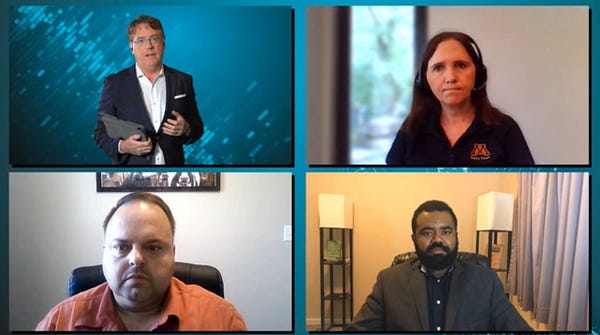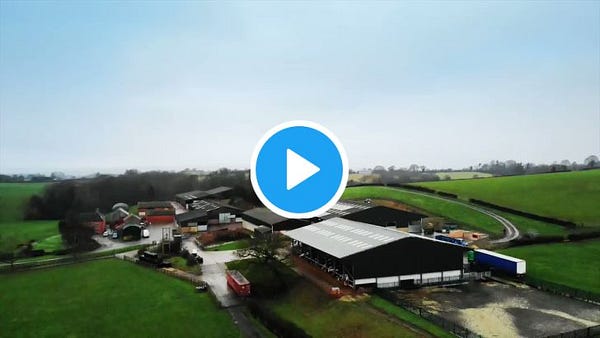In case you missed it … dairy tech start ups in the spotlight
Investment analyst reveals 4 necessary traits of successful agtech startups
The biggest news this week was the first-ever Global Dairy Tech Start-up Spotlight. More than 700 people logged in from around the world to hear 10 start-ups give their elevator pitches for how their cow tech would address the needs of dairy farmers. All of the companies were asked to answer three questions in their 10-minute presentation and Q&A with a panel of experts.
Here were the questions they attempted to answer: What technology are you offering? What are the costs/benefits of the technology? Why is your technology needed now and in the future?

Here were my top headlines from each of the companies that presented at the conference:
PharmRobotics
• What? A robotic arm positioned at the exit alley leading away from parlor to administer vaccines and reproductive products
• Cost-benefit? On dairy farms using timed A.I., employees administer 15,000 to 18,0000 shots per 1,000 cows per year. The cost of labor to administer shots and the average inaccuracy of shot protocols can cost a farm up to $285 per cow per year. ROI of this tech is estimated at 1 to 3 years.
• Why needed in the future? Skilled labor shortages and increasing demands for traceability of pharmaceuticals used on farms
Cainthus
• What? Computer vision and artificial intelligence to monitor feed availability and cow comfort
• Cost-benefit? “Initial data is looking like a 3-to-1 return”
• Why needed in the future? To benchmark the effect of management practices on daily time budgets for cows. “The exciting part of computer vision technology is if you can see it, we can essentially train the system to see it too.”
Livestock Water Recycling
• What? A digitized, automated platform to manage manure nutrient monitoring, extraction and utilization
• Cost-benefit? 18 percent savings on manure polymer dosing costs
• Why needed in the future? The system can recycle up to 75 percent of clean water being lost to lagoons and may create the possibility of a lagoon-free waste stream
Labby
• What? In-line and portable optical sensors for raw milk used to detect mastitis. It tests for milk fat, protein and SCC in under 10 seconds.
• Cost-benefit? Pricing is 70 percent cheaper than other similar services. ROI possible in less than six months.
• Why needed in the future? Milk quality results can be provided in minutes instead of days. Gives better visibility to animal health, milk quality and feed efficiency
milc
• What? Subscription, cloud-based software for feed management, pulsation monitoring and employee on-boarding / training
• Cost-benefit? N/A
• Why needed in the future? It’s a flexible, scalable management software solution. It’s simple to get started and to use. “With our software you can get up and running within a day. Get management reports from anywhere through a smartphone app without TeamViewer.”
Zisk
• What? A real-time margin and revenue projection app: “A crystal ball for farmers”
• Cost-benefit? Free. It’s a downloadable smartphone application.
• Why needed in the future? To proactively manage low milk prices and financial distress. “Dairymen use the milk price as a barometer for their emotions of the day. If milk prices are up, they’re having a good day. If milk prices are down, not such a great day.” With the app, dairy owners can start to visualize how risk management strategies could impact gross margins.
Advanced Animal Diagnostics
• What? An on-farm mini lab to detect subclinical mastitis using leukocyte counts
• Cost-benefit? At least $200 saved for every subclinical mastitis case detected
• Why needed in the future? To better detect mastitis cases and understand what’s going on with somatic cell counts and thus better manage mastitis treatment plans
EIO Diagnostics
• What? Computer vision and machine learning to detect and monitor for early indications of mastitis via udder inflammation and swelling
• Cost-benefit? Only $12 per cow per year
• Why needed in the future? Fast detection of mastitis is needed in rotary parlor applications. The system can also be used as an affordable alternative to RFID identification.
Fyto
• What? Push-button-grown, soy-like protein that feeds like a forage from on-farm cultivated aquatic plants
• Cost-benefit? Grow 10 to 20 times more protein per acre per year.
• Why needed in the future? Automated growth and feeding of protein to cows year-round that doesn’t require arable land. Uses processed dairy cow manure as one of the inputs to the system.
SomaDetect
• What? In-line optical sensor and artificial intelligence to improve reproduction and mastitis detection
• Cost-benefit? Reduce the number of cows requiring preg checks by ultrasound or palpation by up to 50 percent
• Why needed in the future? Decrease early embryonic loss and days open. “Identify if cows are pregnant by doing something that you're doing anyway – milking cows.”


The start up presentations were reviewed by a panel of three industry experts. The trio included Marcia Endres, PhD, professor and director of graduate studies, animal science, University of Minnesota - Twin Cities; Joao H.C. Costa, PhD, professor, dairy science, University of Kentucky; and Jeffrey Bewley, PhD, analytics and innovation scientist at Holstein Association USA.
“Thank you for bringing these [technology] examples. Remember, these are startups and not 100% of them will become viable in the future, but we hope that a lot of these will make it,” Endres said at the conclusion of the event.
Watch the event in its entirety here.

Source: “Five in 15” webinar, Oct. 1Ag tech analyst Sarai Kemp joined Charleston Orwig’s “Five in 15 Webinar” series to talk about agtech investing. Kemp is the VP of Business Development for The Trendlines Group, an Israeli medical, agrifood and laboratory tech investment group. The group’s notable investments in cow tech are miRobot.
“Israel for many years since its establishment has been a pioneer in agriculture, and I think not many know that,” Kemp said.
At any given moment in Israel, there are 500 agrifood start-ups in operation. Kemp said the reason for all of the start-up activity within the country is the country’s desire for food independence and an overall lack of generational farming families.
“We don't have traditional agriculture. And this is an advantage, because when it comes to inventing technology, you need to think out of the box,” Kemp said.
Kemp reported that her investment group has a track record of financing companies that eventually go on to be viable 65 percent of the time. She explained the “foundation for their success” is to find startups that have what she called “the four pillars.”
The team - “You want to know if the team that you invest in can take the company to the next space.”
The technology – “It needs to be really a groundbreaking technology – something that is different, unique and protected. If it cannot be patented (such as software), then it needs to be protected in some way. If it is software, it needs to be very sophisticated software.”
The market - “For us, the technology needs to be used in a really huge market – billions of dollars in that market.”
The need - “The ‘need’ needs to be screaming. It needs to very obvious to everybody what type of need the farmer has. And the technology really needs to answer that unmet need.”
Learn more about The Trendlines Group here.
Researchers at Kansas State University are getting into the cattle facial recognition game for beef cattle. Using images from 1,000 feeder cattle, a team of computer engineers have created an artificial intelligence that is 94 percent accurate in identifying cattle. The newly developed technology should be available in a smartphone app in a couple of months.
“The major limitation right now is the size of the database. … Achieving buy-in from the beef industry is absolutely essential to make this as robust as possible.”
—KC Olson, beef cattle scientist with K-State Research and Extension
Read more here.
A new feature from VAS allows producers to account for how they are paid for fat and protein components when predicting cow values. The software’s COWVAL function helps producers make culling decisions based on economic projections. A new modified version of the function (COWVAL\F) will now account for additional value beyond the typical component levels found in raw milk.
Read more here.
Lely teased more of what it may announce during its upcoming event next week. On Lely North America’s Twitter feed, the company teased that it may have something new to announce to help predict cow diseases.


Lely Future Farm Days 2020 will occur Oct. 6. Learn more here.
Like what you saw in this newsletter? Subscribe today.



